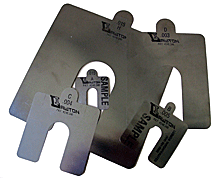UPTIME • April/May 2013
 There is much more to proper shimming of machines for alignment than meets the eye. There are a number of things you should consider and look out for when selecting and using shims.
There is much more to proper shimming of machines for alignment than meets the eye. There are a number of things you should consider and look out for when selecting and using shims.
First and foremost, you should be using high-quality, precut slotted stainless steel shims. Cutting your own shims by hand out of cheaper rolls of carbon steel or brass shim stock may save you money in materials, but will prove far more expensive overall for several reasons. For one thing, you will be able to cut only the thinner thicknesses with scissors or shears, whereas thicker thicknesses (over 0.004″) will require using an acetylene torch or a saw, which is labor-intensive and presents several safety concerns. After you have cut your shims by hand, it is essential to deburr them carefully with a ball-peen hammer and file. All of this will cost you the most valuable commodity of all: time. Moreover, the end result will be fewer available shim thicknesses than you would otherwise have with precut stainless steel shims, resulting in less precise alignments. In addition, if you are cutting shims by hand, there is a far higher risk of minor cuts, requiring a visit to the nurse for a bandage, with the attendant’s loss of time and safety-reporting paperwork this would entail.
It is important to select your brand of precut stainless steel shims carefully, as they vary widely in quality and tolerances. It is extremely important that the shim be of consistent quality, completely even in its thickness throughout, accurate in its thickness, flat and burr-free. Also, it should have no hazardous sharp edges. The metallurgy of the shim is also important to guarantee its hardness and corrosion resistance. Only the best quality precut stainless steel shims offer all these features. An excellent shim will always save you time and money in the long run.
Read my entire article Best Practices: Machinery Alignment Shimming and learn why:
Filed under:
Alignment by Alan Luedeking CRL CMRP
